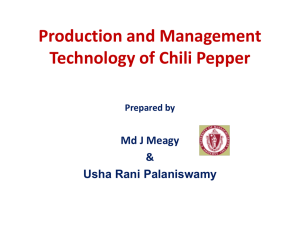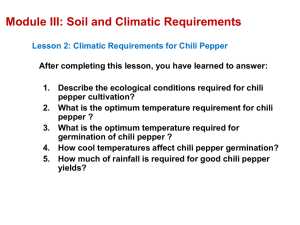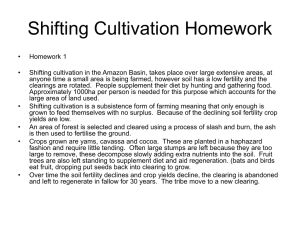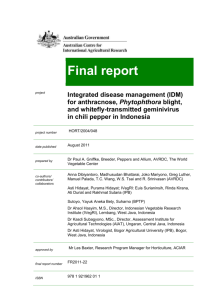Module IV: Field Preparation
advertisement
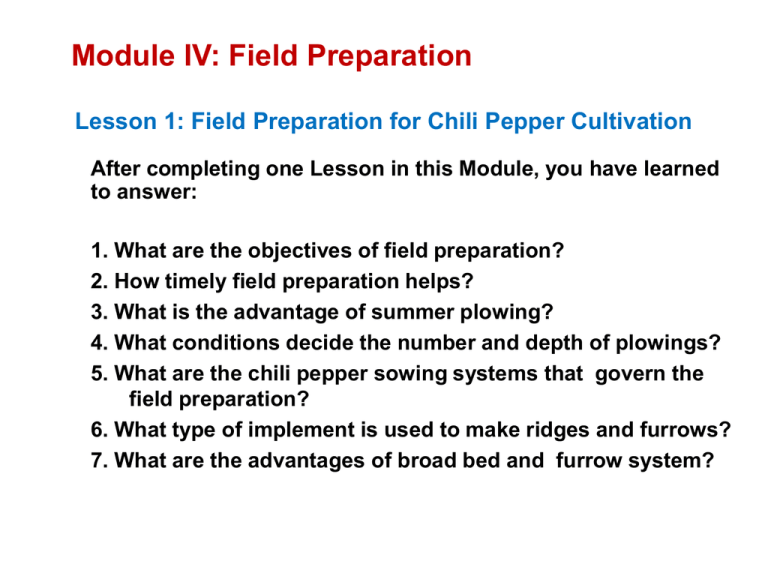
Module IV: Field Preparation Lesson 1: Field Preparation for Chili Pepper Cultivation After completing one Lesson in this Module, you have learned to answer: 1. What are the objectives of field preparation? 2. How timely field preparation helps? 3. What is the advantage of summer plowing? 4. What conditions decide the number and depth of plowings? 5. What are the chili pepper sowing systems that govern the field preparation? 6. What type of implement is used to make ridges and furrows? 7. What are the advantages of broad bed and furrow system? Module III: Soil and Climatic Requirements Lesson 1: Field Preparation for Chili Pepper Cultivation The objectives of field preparation are based on the following principles: 1. Elimination and control of undesirable plants like crop volunteers and weeds to reduce competition with the established main crop; 2. Provide favorable conditions for sowing, allowing germination, emergence and good plant development; 3. Maintenance of fertility and productivity over the long term by preserving the soil organic matter and avoiding erosion; Module IV: Field Preparation Lesson 1: Field Preparation for Chili Pepper Cultivation The objectives of field preparation are based on the following principles: 4. Breaking of hard pans or compacted layers to increase water infiltration through the soil whilst avoiding erosion; 5. Facilitating mixing of fertilizers, lime, or agro-chemical products into the soil; 6. Incorporation of organic and agricultural residues. Module III: Soil and Climatic Requirements Lesson 1: Field Preparation for Chili Pepper Cultivation The land/field plot needs to be carefully selected and prepared for the crop. Crop rotations should avoid sequences in which peppers are planted immediately following another Solanaceous crop such as tomato, eggplant, or potato. Planting after a paddy rice crop is often helpful in that the flooded soil is depleted of many soil-borne pathogens and weed seeds. Addition of compost, animal manures, or green manures can boost the soil’s organic matter content and improve the soil’s nutrient buffering capacity. Module III: Soil and Climatic Requirements Lesson 1: Field Preparation for Chili Pepper Cultivation The soil should be loosened as deeply as practical, and laid into beds according to local practices. Raised bed plantings are useful during raining periods; they improve the aeration of the pepper’s roots and minimize losses due to root diseases and flooding. Planting on flat land can also be done in pits to conserve water in dry areas Module IV: Field Preparation Lesson 1: Field Preparation for Chili Pepper Cultivation Timely field preparation facilitates timely sowing which ensures higher yield. Land preparation should ensure that all crop residues, crop volunteers and weeds are completely buried. Summer plowing is advantageous to kill the weed seeds and hibernating insects and disease organisms by exposing them to the heat of summer. Module IV: Field Preparation Lesson 1: Field Preparation for Chili Pepper Cultivation Initial plowing should be carried out at optimum moisture range to get good tilth and should avoid when moisture is in excess. Number and depth of plowings depends on weed intensity. For rainy season crop, with onset of rains in May-June, the field is ploughed once or twice to obtain a good tilth. Harrowing of soil should invariably followed after each plowing to reduce the clod size. Module IV: Field Preparation Lesson 1: Field Preparation for Chili Pepper Cultivation After the initial plowing, the subsequent plowings and harrowings are carried out when the moisture content of the clods are reduced. The number of plowings are to be minimized to reduce the cost of cultivation. Tillage operations should be repeated when the weed seeds are just germinated. When the soils are heavily infested with perennial weeds like Cynodon or Cyperus, deep plowing is needed. Module IV: Field Preparation Lesson 1: Field Preparation for Chili Pepper Cultivation Moisture is a critical element in good seedbed preparation and is essential for the successful establishment of the crop. Field preparation depends on the system of chili pepper seed bed and seedlings sowing. Two systems of chili pepper seedlings sowing are followed: • sowing on a flat surface, or • on a raised bed system. Module IV: Field Preparation Lesson 1: Field Preparation for Chili Pepper Cultivation If sowing is done on a flat surface, the land should be leveled after final plowing using bullock-drawn or tractor-drawn levelers. Chain attached to a wooden frame of a plow to level the land Module IV: Field Preparation Lesson 1: Field Preparation for Chili Pepper Cultivation Two ridgers may be fastened on a tool bar so that the top of the bed is 1.2 m wide and the distance from the center of one furrow to the center of the next furrow is 1.5 m. The depth of furrows should be 15 cm or more. Making raised-bed with Agribar Module IV: Field Preparation Lesson 1: Field Preparation for Chili Pepper Cultivation The raised bed system has many advantages over flat sowing. They are: • helps in draining off excess water in the field and soil; • provides more soil aeration for plant growth; • greater in-situ moisture conservation; • easier for weeding and mechanical harvesting. Module IV: Field Preparation Lesson 1: Field Preparation for Chili Pepper Cultivation

